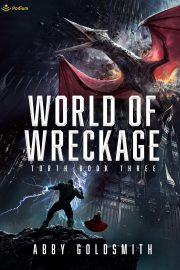The Gamemaster’s Guide to Short Story Plot
By Ursula Whitcher
My first fictional love was tabletop role-playing games, from Dungeons & Dragons and ’90s classics like Vampire: The Masquerade to indie hits such as Visigoths vs. Mall Goths. After all that gaming, I thought I knew how to tell stories. But when I began trying to write and sell short fiction, I ran into a problem I didn’t anticipate.
I knew how to begin a story. Every gamemaster does that: you set up a scenario, hand it to your players, and watch them do something you didn’t expect. (In the case of my high school Vampire-playing friends, they drained the hapless bureaucrat’s blood instead of bribing him.) Campaigns lasted until outside forces wrecked them—until players graduated, broke up, or were distracted by a worldwide pandemic.
I didn’t know how to end stories on purpose. I tried making a list of things that could happen and writing a story where they happened. This was a good first step! But I couldn’t sell the result. The personal rejections hinted at a classic critique: my characters seemed passive. This was confusing. In my head my characters were skilled and opinionated. They didn’t feel passive.
In gaming terms, the problem is easy to describe: I was railroading my characters. I decided what would happen before I started writing, then forced it to occur. As a result, my stories felt like they were about me, not about their heroes.
When you’re running a game, the fix for railroading is to back off and talk to your players. It’s harder to back off and have a conversation with yourself. I flailed. But I eventually found a strategy for writing a satisfying short story. Set up the problem like a gamemaster. Solve the problem like a player.
When you’re the gamemaster, you know a lot about your setting, from the magic rules to whether the tavern bartender is single. You have to persuade your players to engage with this world, so you set up a problem for them to solve. You probably have ideas for a solution—perhaps there’s a werewolf in town, and the gunsmith sells silver bullets—but your focus is on designing a meaningful challenge. When you’re a player, you know your character’s skills and traumas. You may draw on acquaintances or equipment from the wider game world, but your focus is on what your character can do.
In writing terms, this means that in the first half of your draft, wearing your gamemaster hat, you can revel in your setting. Introduce details purely because you like them. Keep writing until you’ve established the core problem. For a short story, this should be a one shot-sized problem: save the campaign ideas for a novel.
Once the scenario is established, switch gears and attack the problem like a player. You know your protagonist’s skills and traumas. You can use anything already in the world. You likely have some idea about the best solution to the problem you’ve set up, but don’t start there. Let your protagonist do whatever your protagonist would do.
Let’s look at a specific story to see how a writer establishes a problem and how the character solves it. Marie Brennan’s “Silver Necklace, Golden Ring” tells us the problem up front: “He takes them for his servants, and never after are they seen again.” The beginning fills in the details: who is “he,” who is taken as a servant, and why would she disappear?
“He” is Nievre, an ice-cold supernatural figure. The protagonist is a peasant woman who has heard that she can escape Nievre by proposing an impossible task. She vows, “I will never step under the roof of one who has not died three times.” Nievre’s response? “Then kill me.”
The young woman kills Nievre three times, in increasingly gruesome ways. Each time he rises again. She asks for help from her brothers, who give her a pretty necklace, but they flinch from the corpse. Reborn, Nievre drags her to his castle.
At this point, we shift into problem-solving mode. We know the protagonist isn’t too proud for hard work. We know she can be ruthless. We also know she’s willing to ask for help. It’s a folktale, so the castle has invisible denizens. The young woman asks a zephyr how she can escape death—and she’s both humble enough and ruthless enough to take its advice.
Though Brennan is a gamer, I don’t know whether she approached her story like a game. Let me tell you about a story where I’m certain the writer created the plot through player-style improvisation, because I wrote it. The story is “The Spirits of Cabassus,” which I wrote for the Lesbian Historic Motif Podcast.
“Spirits” is set in a religious community in fourth-century Byzantium. The protagonist, Prisca, isn’t sure whether the strange cloud around her gorgeous roommate is a migraine aura or a curse. (Spoiler: it’s definitely a curse.) This problem takes a lot of setup. I had to make Prisca’s migraines convincing and establish her world. Fourth-century Byzantines enslaved people, and I didn’t want to lie about that, so I introduced a formerly enslaved character, Balsamea, who teaches Prisca the ascetic skill of baking bread.
Prisca’s first tactic is to ask Balsamea for help. This startled me—I was used to characters who stab things—but Prisca is a kinder soul. Based on a clue from Balsamea, Prisca blocks her nose with wax, in imitation of the wax Odysseus used to block the Sirens’ song. This prompts an incredibly embarrassing conversation.
When you surprise yourself, you surprise your readers too. As Prisca becomes more confident, her story becomes funnier!
Counterintuitively, letting a protagonist solve their own problems can also make a story arc cleaner. As characters use aspects of their world, throwaway detail transforms into foreshadowing. Brennan’s peasant woman uses her brothers’ necklace to preserve her soul; Prisca’s chatter about childhood reading explains adult access to the arcane texts she needs to pacify a ghost.
As I trusted my characters more, my outlines grew sketchier—I wrote telegraphic notes like “PROTAGONIST acts SMART.” My stories had a new crispness, created not by my design, but by my characters’ desires.
 Ursula Whitcher is a writer, mathematician, and poet who has multiclassed a thief/paladin, run an Aztec cyberpunk Fate campaign, and accidentally murdered a deity. Look for Ursula’s short fiction in Asimov’s Science Fiction Magazine and Cossmass Infinities or on the Lesbian Historic Motif Podcast. Ursula’s collection of linked short stories, North Continent Ribbon, will be published by Neon Hemlock Press in 2024.
Ursula Whitcher is a writer, mathematician, and poet who has multiclassed a thief/paladin, run an Aztec cyberpunk Fate campaign, and accidentally murdered a deity. Look for Ursula’s short fiction in Asimov’s Science Fiction Magazine and Cossmass Infinities or on the Lesbian Historic Motif Podcast. Ursula’s collection of linked short stories, North Continent Ribbon, will be published by Neon Hemlock Press in 2024.


